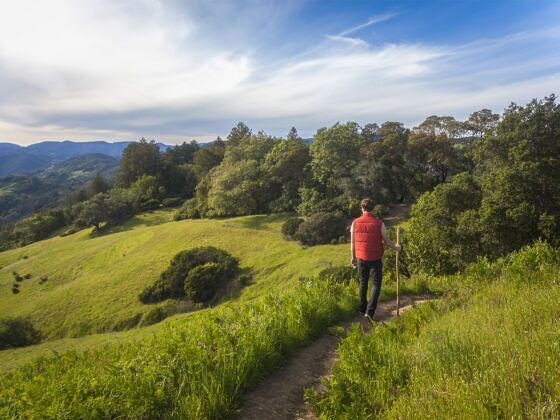Intentional Travel Guide: 5 Ways to Visit Sonoma County Mindfully
Northern California’s superlatives converge in Sonoma County — from its rustic coastline through verdant redwood forests to its lush valleys peppered with inviting towns and world-class vineyards. But Sonoma County isn’t exactly a local secret, and the destination’s long-term commitment to stewardship and sustainability requires each and every visitor to be conscious of their role in protecting this gorgeous slice of our planet.
Whether you’ve come to discover wondrous wild places, to sample award-winning wines, or to simply sink into the culture, the best way to enjoy Sonoma County is mindfully and sustainably. Visitors to Sonoma County are invited to pledge their support to “Travel Kindly” and choose to make a positive impact on the health and well-being of the county’s thriving local communities, abundant experiences, and breathtaking natural landscapes.
When you’re ready, here are five mindful ways to explore Sonoma County.

As you drive north from San Francisco, the California coastline feels ever more remote, offering up rugged vistas, rocky cliffs and beaches, and crashing Pacific waves. Come prepared and pack those layers, as the coast can get foggy — but this simply adds to Sonoma County’s evocativeness.
Highlights where land meets sea include Sonoma Coast State Park, which unfurls for 17 twisty miles up the coast. At the park’s southern end, Bodega Head features an ocean overlook from where you can spot gray whales migrating between the Arctic and Mexico — sightings occur January to May and again in early fall. Just north in Jenner, Goat Rock Beach is a crescent-shaped cove at the mouth of the Russian River, punctuated by an offshore natural monolith. An unhurried walk on this sandy stretch is a perfect way to savor its untamed beauty.
The wildness here impresses — and you’re invited to help preserve it. Visit in off-peak times, like on weekdays or during the cooler months, to avoid overcrowding and enjoy the solitude that makes this corner of the world so special. What’s more, always plan to pack out what you bring in to alleviate stress on local facilities.
Take your time to enjoy the area by staying a night or two. At the Timber Cove Resort, you’ll watch the sun set over the sea right from your bedroom. The resort’s Coast Kitchen is a culinary destination of its own, serving flawlessly executed dishes that call on the region’s bounty of organic produce, naturally raised meats, and ultra-fresh seafood. Naturally, pair your meal with Sonoma County wines or locally brewed beers to double-down on dining fresh and local.
Sonoma County is full of towns so picturesque it’s amazing to think this is where people actually live. Make a stop in the county’s namesake community, Sonoma, to visit the photogenic central plaza built in 1835. On the other side of the county, the hilly hamlet of Occidental has a tiny main street that’s sheltered by towering redwoods.
With a population of fewer than 8,000 residents, Sebastopol ranks as one of the most livable cities in America. It lies alongside the Laguna de Santa Rosa Wetlands Preserve, the largest freshwater marsh in Northern California and a wonderful place to birdwatch. While Sepastopol’s apple and plum orchards have been outpaced by its vineyards in recent years, other pursuits have also taken root here — among them the arts.
The Sebastopol Center for the Arts creates and promotes local, national, and international artists and is well worth a visit. Meanwhile, Sonoma County’s sustainable ethos and Sebastopol’s art focus come together on Florence Avenue, where trash becomes whimsical art from creators like Patrick Amiot. Then there’s the charming West County Museum, which preserves the history of the region and deserves a slot on your itinerary.
Southeast of Sebastopol, the town of Petaluma is packed with upscale restaurants and smart boutiques. Shopping at locally owned stores is perhaps the easiest way to travel sustainably. Not only is it an antidote to carbon-intensive commerce that crosses oceans and continents but spending your money on locally grown or crafted goods supports the grocers, artisans, and small business owners who are sharing their community with you.
The California wine industry began in Sonoma County in 1856, when Hungarian immigrant Agoston Haraszthy planted the first top-quality vines near the town of Sonoma. Today, the county is one of the premier wine destinations in the world, famed for its pinot noir, chardonnay, zinfandel, and cabernets. A leisurely bike ride up winding, tree-shaded West Dry Creek Road in Healdsburg, for example, takes you past several notable wineries within 30 minutes.
Sonoma County is also at the forefront of sustainable wine production. On your West Dry Creek bike ride, visit Quivira Vineyards & Winery, which has actively worked to reduce the amount of water it takes to make each bottle of its celebrated zinfandels and sauvignon blancs, among others. Beyond tasting the eco-friendly wines, you should also tour the sustainable farm and garden.
Possibly the best thing about Sonoma County is that it incorporates so much more than just wine. You’ll encounter plenty of gourmet food, shopping in local stores, hiking, biking, and opportunities to simply admire the view — think golden vineyards in the fall and wildflowers in spring.
In the “Lavender Month of June,” you’ll find captivating purple fields at places like Matanzas Creek Winery. Organically farmed, their lavender fields provide a habitat for honeybees. Admire the violet-hued expanses and take in their indulgent fragrance while sipping a sauvignon blanc from the winery’s terrace. You can also bring some of the lavender home with you, in the form of the many products for kitchen, home, and body made with dried lavender flowers and sold at the winery market.
California’s coast redwoods, sequoia sempervirens, are remarkable trees. The tallest living organisms on Earth, they’re among the oldest as well, averaging 500-700 years in age and sometimes living up to 2,000 years.
When California’s population began to grow in the 1850s, many ancient redwoods were felled for their excellent hardwood. Almost 95% of them were lost before a determined group of Californians succeeded in saving the remaining groves. Sonoma County’s Armstrong Redwoods State Natural Reserve is one such extraordinary site.
Like other places where coast redwoods thrive, the area gets plenty of fog — that’s actually the source of much of the trees’ water intake. Walking on the fern-studded forest floor of the Armstrong Reserve and gazing up at the foggy redwood canopy high above is an awe-inspiring experience.
There’s no camping or lodging in the Armstrong Reserve, but there are plenty of overnight accommodations in nearby Guerneville, including the one and only Highlands Resort. It’s been welcoming straight and LGBTQ+ travelers for decades in its 1940s and ’50s-style cabins and, more recently, in new glamping tents. The resort sits right next to the Russian River, which bursts with activity during busy summer weekends.
Another option for booking overnight accommodations in Sonoma County is Kind Traveler. This “Give and Get” hotel booking and education platform empowers travelers to make a positive community and environmental impact to Sonoma County.
Before you travel, always check conditions and heed any weather-related warnings. If crowds seem likely, seek to modify your plans, as overcrowding can stress the natural environment — and you as well. It turns out traveling sustainably is good for the traveler, too.
The Russian River stretches across Sonoma County and runs through the irresistible town of Healdsburg, with its own plaza in a much more small-town scale than that of Sonoma. At Healdsburg Veterans Memorial Beach, there are shady picnic facilities and a wide stretch of sand just downstream from the historic Healdsburg Memorial Bridge. The beach is open for summertime swimming in high-flow years (wade in the cool water when river levels are low).
Recent years have seen average water levels declining, as California continues to suffer droughts. Water is precious in these parts, and that’s something to keep in mind as you explore the area. Abide by all campfire regulations and seek to use water thoughtfully during your stay.
Likewise, when you do enjoy the river, please find ways to do so responsibly. Consider going at less popular times, and always make sure you’re following Leave No Trace principles and packing out everything you pack in. Strive to leave this gorgeous place even more beautiful than you found it, to preserve its grandeur for all to enjoy.

